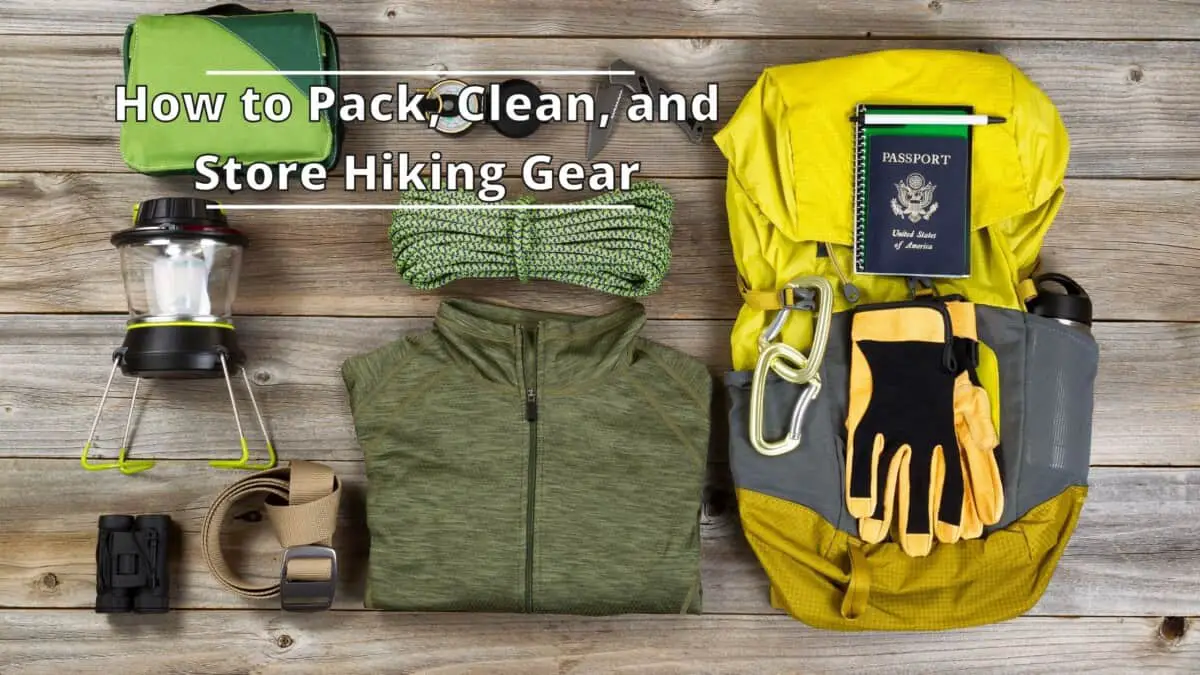Packing, cleaning, and storing is the process you should follow every time you go on a trip. Plan the things you need to pack, clean them afterward, and store them for future use. This is important to avoid damage and preserve your gear.
When packing your things, always prioritize the essentials based on the kind of trips you are taking. You can wash your belongings in a washing machine, or scrub them. After cleaning your gear, store them in a cool, dry place. Avoid folding your tent, as this can tear the fabric.
We will be sharing different tips to follow if you are going on a trip, and will tell you the things you need to do afterward. This includes how to pack, clean, and store your hiking gear, as well as techniques for packing your backpack.
Whether you’re going on a quick day hike or a multi-day backpacking trip, you’ll need a reliable hiking backpack to help you carry and store your hiking gear. If you’re not sure about which pack you should get, check out our article about the best hiking backpacks to see which ones are our favorites.
How to pack your hiking gear before hiking
Before you hike, you should pack the most essential things and arrange your stuff by weight. Create a checklist of the items to bring, and don’t forget to pack your tent last. If you want to make the most of your car storage, equip it with a rooftop car carrier.
Follow these tips to pack your gear more efficiently.
-
Place your things in your backpack by weight
For further guidance, you can check out our article on How to Pack for a Day Hike, as we have discussed how to use every pocket in a backpack. Following is a summary of how to organize by layers:
-
- Heavy items – Bottom layer
- Moderate – Core (main storage of the backpack)
- Commonly used items – Top layer
-
Prioritize the essentials
Place commonly used materials on the top layer, which you can easily access. This will allow you to get your essentials without digging into the other layers.
-
Don’t forget the essential stuff
Following are the essentials that you will need when hiking, as per our How to Pack for a Day Hike article:
-
- Food and water
- Multi-tool pocket knife or multi-tool equipment
- Hiking footwear
- Backpack
- Proper clothes for hiking
- Compass
- First-aid kit
- Necessary body essentials or medication
-
Create a checklist
By making a checklist ahead of your hiking or camping trip, you’ll be ensuring that you won’t be forgetting to pack anything. It is recommended that you be prepared, because hiking will take you to places that lack the things you will need.
-
Pack your tent
The tent will be the last thing you pack. If you are going to bring along your vehicle to transport your things, this is the best advice to follow. The last piece of equipment you pack will also be the first thing you unpack.
-
Equip your vehicle with extra storage
Install a rooftop car carrier and nets to hold your equipment in your car. We advise using a rooftop car carrier if you will be packing a lot of items that you can’t store inside your car.
An added tip: If you would like to keep your food cool, place some frozen water bottles in your cooler.
Hiking is an activity that might require a lot of gear. However, the cost of hiking equipment can quickly add up, especially if you want reliable gear. Thus, it can be difficult to budget perfectly for several hiking trips. So, how do you get free hiking gear? Read our article to find out.
Techniques to pack your hiking gear in a backpack
There are few techniques for packing your hiking gear. First is to choose the right backpack. Then, pack the most essential gear, adjust the straps, organize your things by layer, and alter the backpack for comfortable carrying.
-
Choose a proper backpack
You can check out our article, How to Choose a Hiking Backpack, for more information. The first thing to keep in mind is how long you are planning to hike, because this will greatly affect the amount of items you pack.
Note the following:
-
- 10 to 25 liters – day hiking or hours
- 30 to 40 liters – weekend hiking
- 50 to 80 liters – multi-day hiking
- 65 liters and up – extended hiking
-
Pack the important gear
Prioritize the essentials — extra clothes, food, and water. However, if you have space left, you can add other things you need to pack. Always rank them in order of importance.
-
Adjust the backpack straps: loosen and tighten
Disconnect or loosen the straps of your pack before you place your stuff inside it. These straps work to tighten your hold on the things inside your backpack. Adjust them to the appropriate size after you’ve packed your things.
-
Organize your things by layer
As previously mentioned in the “How to Pack Your Hiking Gear Before Hiking” section of this article, pack your things by layering them in your backpack. Put heavy materials in the main storage area, so that you can maintain an upright posture.
-
Modify the backpack to your body
Fit the straps comfortably to your body. When adjusting the straps, ensure that the backpack weight is properly distributed. Fine-tune the chest and hip straps to the appropriate fit. Also, tighten the shoulder strap, but not so much that it is no longer comfortable.
How to clean your hiking gear after hiking
After hiking, you should properly clean your hiking shoes and gear. Throw it in the washing machine or scrub it if it won’t stand up to the washing machine. Dry your tent, and also wash your utensils and cookware thoroughly. Check with your manufacturer how to clean each piece of equipment.
-
Clean your hiking shoes or boots
Dry your shoes when you get home. Remove the dirt, or wash it off with water if it is hard to get rid of. To avoid bad odors, put baking soda inside your shoes, or wash them with a light detergent. Apply waterproofing materials to preserve your shoes. If the shoes are damaged, take them to a cobbler.
Check out our hiking shoes cleaning guide to know more about this task.
-
Use the washing machine or scrub.
Wash your sleeping bag with a washing machine to clean off the dirt that it picked up from the ground. Not all backpacks can be washed in the washing machine, so you can clean your backpack manually.
-
Dry your tent
Set up your tent outside of your house, so that it can dry out properly. This will prevent the formation of fungi. Also, remove the dirt while you are drying it.
-
Wash the camping utensils and cookware
Even if you washed your utensils and cookware at the campsite, do it again at home to prevent the formation of bacteria. Aside from your utensils, you should also wipe off the dirt from your stove. Remove the fuel, then remove the dirt. Be careful when using some cleaning materials, as they can damage your gear. Contact the manufacturer for further tips and instructions.
Like any valued investment, whether your hiking backpack is cheap or a high-end one, it’s important that you take care of it to ensure that it can last for years. To make sure that you are taking care of your equipment properly, check out our guide on cleaning and maintaining your hiking backpack.
How to store your hiking gear after hiking
Always remember to store your hiking gear in a cool and dry place. Organize it with labels, then store it properly on a shelf. Also avoid placing it in direct sunlight. It is best to roll your tent and hang your sleeping bag to avoid deterioration.
These are the techniques you can follow.
-
Keep your things cool and dry
Tents and hiking shoes are prone to developing mold and fungi if moisture forms, so monitor the storage to prevent this from happening. Also do this for your backpack, as it is vulnerable to damage.
-
Keep your gear out of direct sunlight
Ultraviolet rays can damage your hiking shoes and backpack, so place these in an area where they will not be affected by the sun’s heat.
-
Organize your gear
Sort your gear into groups. According to the American Hiking Society, sleeping bags and tents are categorized into “shelter.” Place cookware and utensils into the “cooking” category, while pads and camping stakes will go in the “ground” group.
-
Label, store, and slide
Place the gear into a storage bin with a label, so that you can easily find it in the future. Once you have done this, you can place the gear on your shelves, where you stock your equipment.
-
Don’t fold your tent
Your tent is vulnerable to being ripped or suffering damages to its fabric. Rolling your tent will avoid these problems.
-
Hang your sleeping bag or lay it on the ground
Hanging your sleeping bag will avoid an increase in temperature or heat. This happens when you roll your sleeping bag and place it in storage. Another technique is to flatten it out, and place it under your bed.
Conclusion
For every hiking trip you take, there will always be a packing, cleaning, and storing process. You can’t just pack your things impulsively. If you don’t organize your equipment properly, there is a very high chance that you will forget to pack something important, or worse, you can damage your equipment.
The best thing that you can do is plan everything before you go hiking. Afterward, don’t forget to take good care of your gear and equipment. And finally, clean and wash everything, then store your equipment, so that it will be as good as new when you use it in the future.

